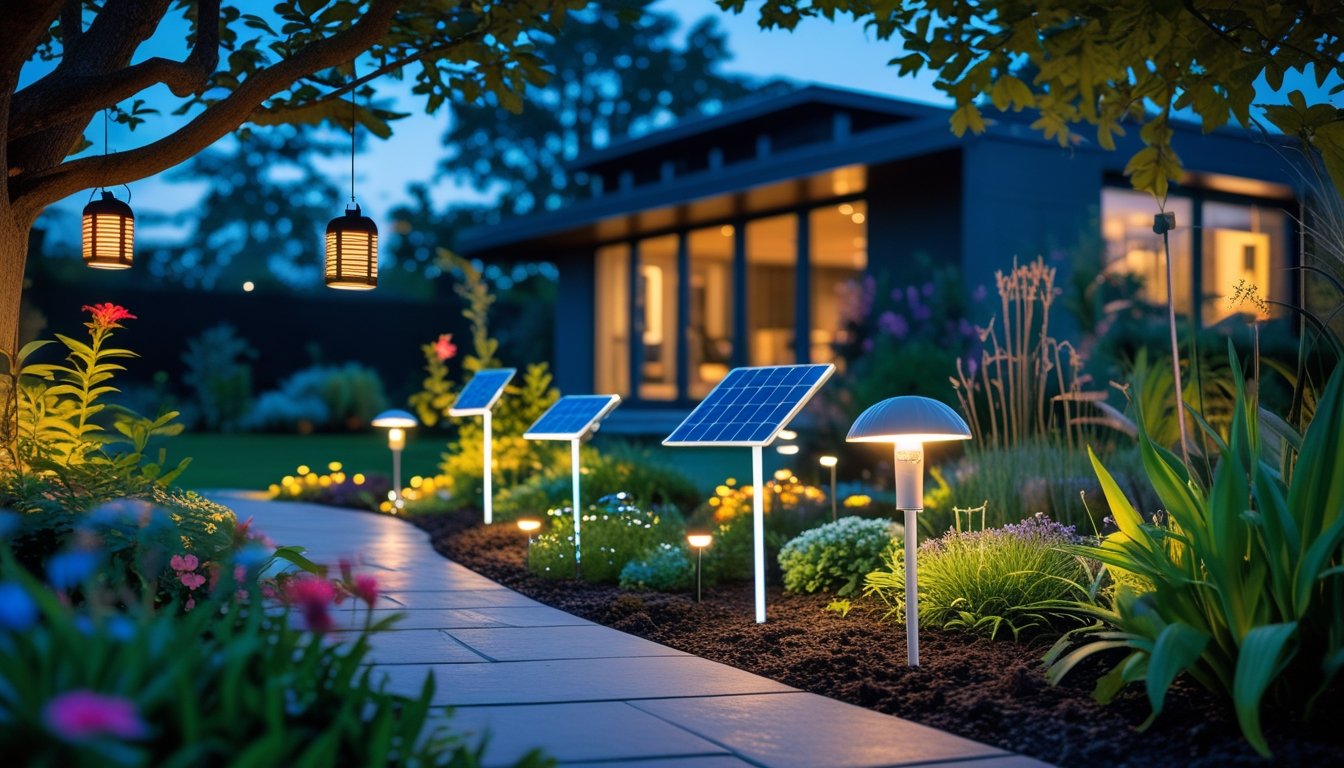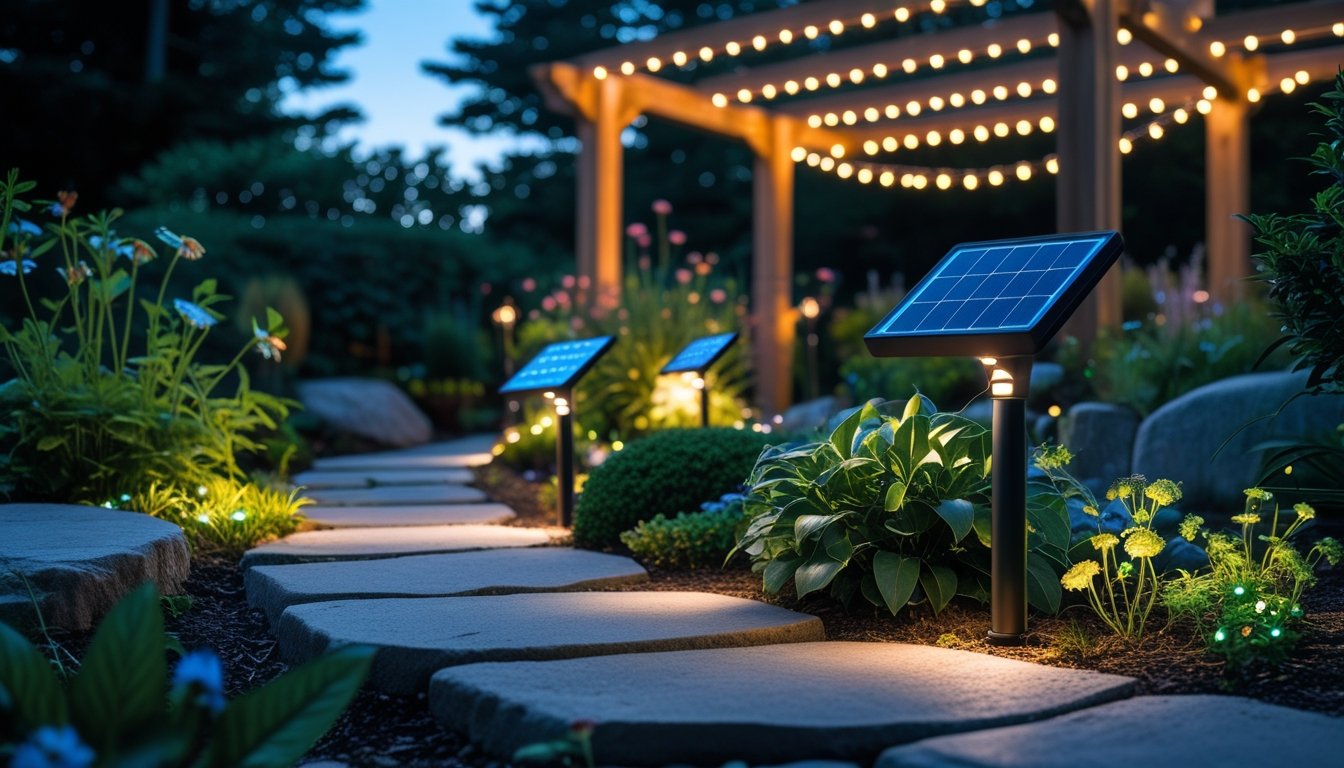Late updated: 15 May 2025 15:05
Written by: James Whitaker
Exploring Eco-Friendly Garden Lighting Options: Sustainable Choices for Your Outdoor Space
Exploring eco-friendly garden lighting options can transform our outdoor spaces into enchanting sanctuaries while being conscious of our environmental footprint. With the increasing awareness of sustainability, more homeowners are opting for greener lighting solutions that not only reduce energy consumption but also enhance the beauty and functionality of their gardens. Low-voltage LED lights, particularly solar-powered varieties, offer a remarkable reduction in energy use, making them a popular choice for the eco-conscious gardener.

As we navigate the multitude of options available, we find that today's lighting products offer notable features. Advances like flicker-free dimming and customisable colours contribute to a pleasant outdoor experience. Additionally, using biodegradable or recyclable materials in lighting fixtures further aligns with sustainable gardening practices.
Key Takeaways
- Choose LED and solar-powered lights for energy efficiency.
- Customisation enhances both aesthetic appeal and functionality.
- Sustainable materials in lighting fixtures support eco-friendly gardens.
Fundamentals of Eco-Friendly Garden Lighting
Eco-friendly garden lighting offers significant benefits by reducing energy consumption and minimising light pollution. These solutions focus on sustainability, using technology like LED and solar power for energy efficiency.
Benefits of Eco-Friendly Outdoor Lighting
Eco-friendly outdoor lighting provides multiple advantages, including reduced energy costs and environmental impact. By using sustainable lighting, we can enhance outdoor decor while supporting biodiversity. Implementing energy-efficient solutions like LED bulbs ensures lower electricity usage and longer bulb lifespan. These fixtures consume less power, making them cost-effective and environmentally friendly.
Moreover, many of these lighting options come with dimming features and intelligent controls. This functionality allows us to adjust the brightness according to needs, helping to minimise the disruption to local wildlife and maintaining a natural ambience.
Key Elements of Energy Efficiency in Garden Lighting
Energy efficiency is paramount in reducing the environmental footprint of garden lighting. One vital element is the use of light-emitting diodes (LEDs). LEDs are known for their low energy consumption and longevity compared to traditional bulbs. These lights emit less heat and are highly efficient, making them an ideal choice.
Another crucial aspect is the integration of solar-powered systems. Solar lighting harnesses energy from the sun, providing a renewable energy source. These systems store energy during the day, ensuring our gardens remain illuminated at night without increasing electricity bills. Solar lighting requires minimal maintenance, further contributing to its effectiveness and sustainability.
Minimising Energy Consumption and Light Pollution
Reducing energy consumption and mitigating light pollution are significant objectives for eco-friendly garden lighting. It is essential to illuminate only necessary areas and use fully shielded fixtures to prevent light scattering. This approach helps focus light where it is needed and limits its impact on the surrounding environment.
Additionally, incorporating intelligent lighting systems with motion sensors ensures lights are active only when required. By doing so, we conserve even more energy and reduce disturbances to nocturnal wildlife. This careful management of lighting enhances tranquillity and preserves the natural beauty of outdoor spaces.
In conclusion, adopting eco-friendly garden lighting practices is an effective way to enhance the aesthetic value of an outdoor space while promoting a sustainable environment. Each small choice contributes to significant benefits for both energy efficiency and conservation efforts.
Popular Eco-Friendly Garden Lighting Options

Incorporating eco-friendly lighting into our gardens can significantly reduce energy consumption and environmental impact. We'll explore solar power, LED solutions, and other sustainable options, each offering unique benefits for garden illumination.
Solar-Powered Lighting Solutions
Solar-powered lighting solutions are a sustainable choice that harness renewable energy. These lights collect sunlight during the day with photovoltaic panels and use it to illuminate garden spaces at night. A key benefit is their low operational cost, as they eliminate the need for external power sources.
Easier to install than wired systems, solar lights often feature DIY installation. They are perfect for illuminating pathways, borders, and patios. Many models include rechargeable batteries that store excess energy for cloudy days. Look for weather-resistant designs to ensure durability through changing seasons.
LED Bulbs and Fixtures for Gardens
LED bulbs and fixtures offer longevity and efficiency for eco-friendly garden lighting. These lights use significantly less energy compared to traditional bulbs and have a long lifespan, making them a suitable choice for sustainability-focused projects. They provide bright and consistent illumination with less heat output.
From globe lights to string and fairy lights to charming Edison bulbs, the versatility of LED options suits various garden styles. Whether used for ambient lighting or creating dramatic shadows, LED fixtures can enhance any outdoor decor.
Low-Voltage Garden Lighting
Low-voltage garden lighting is another efficient option. Operating on 12 volts, these lights consume less power while providing effective illumination for gardens and landscapes. They are safer for outdoor use, reducing the risk of electrical hazards.
These systems are relatively easy to install, often ideal for paths, flower beds, and water features. Look for options that can be integrated with LED bulbs for optimal energy savings. These low-maintenance systems offer both functionality and elegance.
Sustainable Lanterns and Accent Lights
Sustainable lanterns and accent lights can create focal points and enhance the garden's aesthetic. Lanterns, paper lanterns, and accent lights such as path lights or sconces can highlight architectural features or garden elements. They often use renewable energy sources or energy-efficient technologies.
Incorporating weather-resistant materials, these fixtures are designed to withstand outdoor conditions. Whether opting for classic styles or sleek, modern designs, these lights add character and charm while contributing to a sustainable lifestyle. Explore options that allow easy rearrangement to refresh garden layouts.
Frequently Asked Questions

In our exploration of eco-friendly garden lighting, we cover sustainable lighting options and practices for energy efficiency. We also examine materials and light types that minimise environmental and wildlife impact.
What are the most sustainable outdoor lighting options available?
Solar-powered lights are a top choice for sustainability, harnessing the sun's energy. LED lights also offer a sustainable option with their long lifespan and efficiency.
Which materials are considered eco-friendly for garden lights?
Eco-friendly materials include bamboo, recycled glass, and certain metal alloys. These materials reduce environmental impact by being either biodegradable or recyclable, ensuring a smaller ecological footprint.
Which type of light is least interruptive to nocturnal animals?
Amber LEDs are least disruptive to wildlife. With colours at or below 2200 Kelvin, they minimise interference with nocturnal behaviours, making them a considerate choice for garden illumination.
How can I ensure my garden lighting is energy-efficient?
To maximise energy efficiency, use solar-powered or LED lights. These lights consume less electricity and have longer lifespans. Consider using timers or motion sensors to further reduce energy consumption when light isn't needed.
What are the best practices for installing eco-conscious garden illumination?
Position lights to minimise light pollution by directing them where needed. Use shields or fixtures to prevent light spill. Regular maintenance checks ensure optimal performance and energy use.
How do solar-powered garden lights compare to other eco-friendly alternatives?
Solar-powered lights stand out by eliminating the need for electricity, using renewable energy. Although initial costs can be higher, they save on energy bills and reduce overall carbon footprint, making them a highly sustainable choice.
